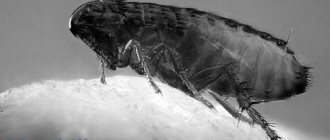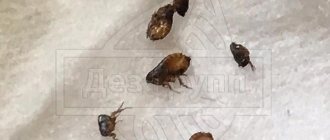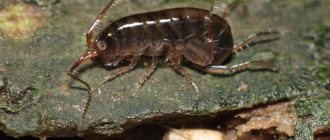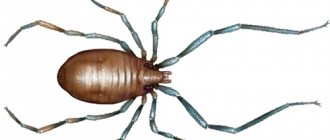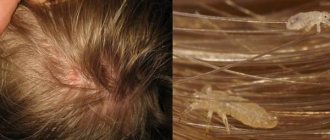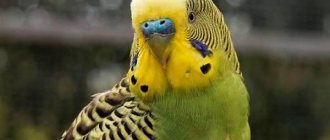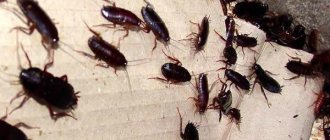How long do fleas live in an apartment, how many days do they die after treatment, why do they not die even when the animals are no longer in the house - the answers to these questions lie in the biology of the parasites.
How long a flea can live without feeding on blood outside an animal depends on environmental conditions and the stage of the insect's life cycle. First, let's establish how many years, months or days earth fleas can live in different circumstances - favorable and extreme.
Structural features
The body of fleas is laterally compressed, narrow, smooth , equipped with bristles and spines that help them move and stay in the thick fur and between the feathers of their hosts, in the folds of clothing, as well as in the substrate of their nests and burrows. The head and chest often have serrated ridges ( ctenidia ).
The size of fleas of different species varies
from 1 to 5 mm , but in females of some species it can reach 10 mm due to hypertrophic growth of the abdomen after the start of feeding.
The antennae are always located behind the simple eyes and, at rest, are placed in special recesses - antennal fossae.
The antennae may be used by males to hold onto a female during copulation . The oral apparatus of fleas is of the piercing-sucking type .
It is characterized by the transformation of epipharynges (unpaired stylet) and lacinia (paired stylets) into stylets, articulated with the maxillary lobes.
The lower lip with a pair of labial palps is transformed into case flaps for the components of the proboscis. The mandibles in adult fleas are completely lost . The chest is equipped with strong limbs, providing the insect with rapid movement in the host's integument and the ability to stay on rough surfaces at any angle.
They often move by jumping, using the second and especially the third pair of legs to push. In the posterior part of the abdomen, behind tergite VIII, there is a unique sensory organ found only in fleas - the abdominal sensillium, or pygidium , equipped with trichobothria (tactile hairs) and capable of detecting air vibrations .
Based on the nature of changes in ploidy, the following types of life cycles :
- Haplophasic : the organism has a single set of chromosomes (n, haploid) throughout the cycle; These life cycles are characteristic of many bacteria and protists that do not have a sexual process.
- Haplophasic with zygotic reduction : after the formation of the zygote (2n), meiosis occurs and the remaining stages of the life cycle are haploid (this life cycle is characteristic of many green and other algae, as well as most other groups of protists and fungi).
- Diplophase with gametic reduction : all stages of the life cycle are diploid (2n), only gametes are haploid (n) - a life cycle characteristic of multicellular animals.
- Haplo-diplophase : at both diploid and haploid stages, mitotic divisions occur, leading to reproduction or growth, and the life cycle contains diploid and haploid generations - a life cycle with intermediate (sporic) reduction, characteristic of all higher plants, as well as foraminifera and some other protists.
By the number of generations (ontogenies) in the life cycle:
- Simple : the cycle includes one generation.
- Complex : cycle includes two or more generations; such a life cycle is characteristic, for example, of many cnidarians (alternating generations of polyps and jellyfish), for most trematodes (alternating generations of marites, sporocysts and redeyes).
What does a flea's mouthparts look like under a microscope?
A flea close-up is a terrifying sight. The photo shows a frontal view of the insect. The head is small and sloping. Behind the simple eyes there are antennae, which the insect retracts into special pits when at rest. Males use antennae to hold the female during mating. This structure of the head ensures that it is deeply immersed in the epidermis of the victim in order to reach the capillary. This is what a flea looks like under an electron microscope in profile.
Flea under a microscope
The oral apparatus of the piercing-sucking type is clearly visible. The upper pair of stilettos gnaws through the skin, the lower one widens the wound. The lower lip is a kind of case for the sucking proboscis. It also contains movable palps - organs of touch. From above, the oral apparatus is covered by a head plate with sharp comb-like projections - ctenidia. An enzyme secreted by the insect's salivary glands prevents blood clotting. The insect does not mask its bite with painkillers, like many blood-sucking fellows.
Flea close up
The abdomen, consisting of 10 segments, can increase as soon as the adult insect begins to feed. The fleas in the photo seem huge; in fact, the size of the flea varies from 1 mm to 5 mm, but in the females of some species the abdomen hypertrophies, and the insect can grow up to 10 mm. The largest are white fleas - alakurts. They are called this because the eggs ripening in the abdomen stretch it, making it almost transparent. Alakurts parasitize the long wool of sheep, but are found on other ungulates - roe deer, goats, gazelle, and elk.
The structural features of these blood-sucking insects also include the presence of a sensory organ characteristic only of this family – the pygidium. Localized behind the 8th segment, the pygidium is equipped with tactile hair-like outgrowths of chitin (trichobothria), which detect air vibrations and inform the insect about a threat.
Appearance
You should immediately understand that fleas are insects that are parasites on the skin and hair of animals living near you. They are used to sucking the blood of rabbits, cats, dogs, chickens, parrots, hamsters and rats.
However, the worst thing is that these small creatures are capable of causing harm directly to humans . Using a special piercing-sucking apparatus, the flea pierces an inconspicuous hole on the surface of the skin of its owner and is saturated with his blood.
The signs by which you can recognize an insect are a smooth body, which has a narrow texture and is somewhat flattened on the sides . It is also worth paying attention to the bristles and small spines that are located throughout the body and serve to ensure that the flea is able to move and stay on the fur of its victim.
The insect's head and chest are covered with so-called serrated combs or ctendia . As for the size of an adult, it ranges from 1 to 5 millimeters. And females that have had enough time sometimes reach 10 millimeters in length.
The flea's head is equipped with special antennas, which, when not needed, hide in antennae pits, and when the insects go hunting, they reappear in order to detect the most vulnerable spot.
How many legs does a flea have? The flea makes its jumps with the help of three pairs of fairly strong paws , which are located on the belly. The sensory organ, which is located on the back of the body, is designed to instantly capture air vibrations in the environment.
Today there are about 1000 species of these insects. Another interesting fact is that representatives of this family often lack vision or have the simplest manifestations of it .
Read more about such types as: human, earthen, bed, herbal.
Studying the life activity of fleas and the characteristics of their body is possible only with the help of a microscope. The largest collection of specimens is in the British Museum. It was collected in Tring by scientists N. Rothschild and K. Jordan.
Origin of the species and description
Photo: Flea
Fleas form a small group of insects that are probably descended from the ancestor Mecoptera (scorpions), with which they share certain characteristics. Both groups have a spinous stomach, sex differences in the number of ganglia in the ventral nerve canal, six rectal glands, and a simple ovary type.
Males have a similar type of sperm, unique to the arthropod phylum, in which a motile flagellum or tail, lacking an outer ring of nine tubules, is located around mitochondria (cellular organelles). Fossil fleas discovered in Australia are said to be 200 million years old. Two other known fossil fleas come from Baltic amber (Oligocene) and are very similar to "modern" fleas.
Video: Flea
Because fleas are capable of jumping horizontal or vertical distances up to 200 times their body length and achieving accelerations of 200 g, they have been described as insects that fly with their feet. Some species that live in nests high above the ground or in other unusual habitats crawl rather than jump.
Fun Fact: Occasional uses of fleas' unusual strength occur in "flea circuses" in which they pull miniature carts and perform other feats.
Photo
What a flea looks like, close-up photo:
Unusual facts about fleas
Interesting facts about fleas are collected in the 6-volume edition of the Catalog of the Rothschild Collection of Fleas in the British Museum. The structure of the flea was studied by M.L. Rodschild, daughter of the famous Charles Rothschild, who collected the largest collection of these insects. It was she who first began to study the mechanism of flea jumping and fully described what they are.
Interesting!
The color of the “vampire” coat depends on the color of the fur of the animal on which the insect parasitizes. There are red, black, and brown fleas. Insects of different ages also differ in color - the darker the color, the younger the imago. The brown digestive tract is visible through the white or yellowish coat of the larvae, as they feed on coagulated blood from the excrement of adult insects.
The weight of blood that a bloodsucker drinks is 6 times greater than that of a flea. Blood helps her not only survive, but also reproduce. A hungry “vampire” falls into a lethargic state. But as soon as you feel the approach of food, the insect “comes to life” and jumps onto the victim.
Flea eggs
Females mate once in their lives, but produce 500-800 eggs. A well-fed female throws out eggs with force, scattering them around. Household fleas lay eggs in carpets, animal bedding, and their fur.
Where do fleas live?
A very large number of flea species are determined by suitable climatic conditions. It is a common belief that the number of fleas varies depending on the time of year.
When a cold period sets in, the number rarely decreases, and, conversely , with the arrival of warmth, insects actively reproduce. The hot months of summer seem to be especially active in this regard.
The greatest danger comes from fleas that live in the apartment and can cause harm to them. Fleas often settle near rodent burrows . As for residential premises, they are most often found in small cracks on the floor , under bedspreads and in dusty places where people cannot penetrate.
Find out where fleas come from in the house?
Remarkable is the fact that a female flea is capable of laying about 400 eggs in her entire life.
What does a flea eat?
Photo: Flea on an animal
Fleas feed exclusively on the blood of mammals (including humans), as well as birds. A flea infestation can lead to severe skin inflammation and severe itching. Although many animals acquire partial immunity after persistent or repeated attacks, individuals (especially humans) can sometimes become sensitized after exposure and develop allergies.
Species that attack people and livestock include:
- cat flea (Ctenocephalides felis);
- the so-called human flea (Pulex irritans);
- dog flea (Ctenocephalides canis);
- sticky flea (Echidnophaga gallinacea);
- penetrating flea (Tunga penetrans);
- European chicken flea (Ceratophyllus gallinae), which can parasitize poultry;
- western chicken flea (Ceratophyllus niger) in the United States.
Some fleas, which feed primarily on rodents or birds, sometimes attack people, especially when their usual host is not present. When rats die from bubonic plague, their hungry fleas, themselves infected with the plague bacilli and seeking food elsewhere, can transmit the disease to people, especially in buildings heavily infested with rats.
The eastern rat flea (Xenopsylla cheopis) is the most effective carrier of plague, but other flea species (eg, Nosopsyllus flaviatus, Xenopsylla brasiliensis, Pulex allerans) can also transmit the disease to humans. Although there are cases of plague in tropical and some temperate regions, the disease in humans can be controlled with early diagnosis and antibiotics.
Interesting Fact: Plague (sylvatic plague) is a widespread disease among hundreds of species of wild rodents around the world, which is maintained in these populations by fleas that parasitize these animals. It is known that more than 100 species of fleas can be infected with the plague bacillus, and another 10 species are carriers of the classic type of urban plague.
Fighting methods
The fight against this misfortune should begin with a number of special measures that can stop the reproduction process and neutralize already born individuals. If there are animals in the house, then it is necessary to treat their fur with special products .
Shampoos and a variety of medications are sold in pet pharmacies especially for these purposes . A very good assistant in this matter is pyrethrum , which veterinarians strongly recommend treating the hair of cats and dogs.
It can also be used to treat all possible places where pests accumulate directly in the home. Folk remedies include sweeping floors with a wormwood broom . A flea collar is also actively used.
How to get rid of fleas in an apartment?
If you already have these parasites in your apartment, then the best remedy for fleas will be special insecticides that can destroy fleas even in the most neglected rooms. Since fleas could not even physically eat poisonous bait, means of combating them are made in the form of sprays, powders and suspensions that affect the nervous system of fleas.
When treating a room with aerosol preparations, it is necessary to temporarily evacuate all the inhabitants of the house, and then thoroughly ventilate the room and do a thorough wet cleaning.
Among the best flea medications are:
- Raptor spray with a pleasant mint scent. It is safe and effective; usually two cylinders are enough to treat a one-room apartment.
- Sinuzan is an effective and professional remedy for fleas. Its disadvantage is the unpleasant smell.
- Biorin is a professional product that destroys not only fleas, but also other insects and parasites.
After exterminating fleas, you should definitely do a general wet cleaning of the house, and generally monitor cleanliness, since unsanitary conditions and dirt are the most favorable environment for these insects.
Lifestyle
Adults differ from many other insects in having a fairly active lifestyle , which is marked by periodic settlements on the body of the prey in order to receive nutrition for further life activity.
What do fleas eat? These parasites drink blood. It is worth noting that when they are full, they most often leave the object and look for a new owner, which makes these insects potential carriers of various diseases .
for fleas to get enough food once a day , but if this process is interrupted for some reason, then they are forced to look for another source of nutrition.
How long can fleas live without food? If it is not possible to find a source of food, then a flea can survive without food for a week, or even a month . As for the host, these parasites are quite unpretentious .
Individuals that live on cats can consume the blood of a dog or human without much embarrassment. However, it is fair to note that fleas that live on chiropterans will never jump onto mammals .
Read more about the dangers of fleas for pets and people here.
How quickly do fleas die when treated with insecticides?
After synchronous treatment of the premises and pets, flea imagoes die within 1-2 days. But the insecticide does not penetrate deep into the carpet, where eggs, larvae and pupae hide. In addition, the cocoon reliably protects the pupa from chemical exposure.
After how many days should I re-treat fleas?
When using long-acting contact preparations, adults emerging from cocoons will die within 3-4 weeks. However, over time, the properties of the chemical weaken. It is recommended to re-treat the premises after 2-3 weeks. As a rule, two or three treatments are enough to remove a colony of domestic fleas.
Flea Behavior and Identification
Fleas are quite active and sense the approach of danger very well thanks to sensory organs that detect the slightest shudders in the air. This is why it is almost impossible to neutralize a flea with bare hands .
There is a high probability that it will move to another owner and continue to be saturated with his blood. We should also not forget that most fleas are not on the animal itself, but in its environment, which complicates the process of pest control.
When purchasing a drug to exterminate parasites from a pet pharmacy, do not forget to inquire about their toxicity level for the animal and check the period of its action.
As you know, it is easier to prevent than to cure. Special animal collars that are impregnated with insecticides will help you with this.
Signs of dangerous pests and the consequences of their bites
The presence of fleas in the house can be recognized by characteristic bites , which are located not only on the head, but also on other parts of the body. Fleas bite into the skin with force, so it is almost impossible not to notice the attack of the parasite.
At the site of the bite, a red spot or blister up to 5 mm in diameter appears with a red dot in the center. In some people, insect saliva can trigger hives or allergic rashes. Bites heal in 3–5 days.
Flea bites are very itchy. By touching wounds with dirty hands, a person can infect them. When pathogenic microorganisms come into contact with the damaged epidermis, suppuration and intoxication occur.
How long does a flea live?
The optimal temperature for flea development is 18–27 degrees, and the most suitable humidity is 70–100%. Under such conditions, the flea grows in 20–49 days .
If the humidity drops below 60%, then the larvae stop the development process, and they completely die in the water .
It is interesting that if environmental conditions cannot be called favorable, then the period when the flea remains sealed in a cocoon may be significantly longer.
The main part of fleas are temporary parasites that use domestic animals and humans only to get enough food in order to continue their life activities.
Flea habitats
These blood-sucking parasites live wherever they can. There is a misconception that fleas fly , but they do not have wings. This is where fleas live in the wild: bird nests (maybe in domestic pigeons), houses, apartments, garden plots, and also in premises where livestock are kept. All representatives of the flea order are nothing more than a generalized image of bloodsuckers. Any warm-blooded organism can become a victim.
Places where fleas live in an apartment : carpeting, space behind baseboard ledges, bedding for pets and in other bedding for them. If there is a lot of clutter, you can easily notice it in the linen closet, inside the sofas. They are found on bed linen due to infrequent linen changes and dust accumulation.
On the ground floors, attics and basements, garbage heaps, grass - in these places, blood-sucking parasites attack rats, mice, cats, dogs. The occurrence of insects in human apartments is facilitated by littering the room with unnecessary things and other things, and an insufficient level of hygienic conditions in the apartment.
Reproduction
Complete metamorphosis is how fleas develop. This means that the egg that hatches as an adult first produces a larva. This larva then turns into a pupa. The larvae do not pose a great danger and are not capable of causing harm .
This is only a transitional stage, the final goal of which is an adult insect, which in the scientific world is called an imago. It is these latter that support their vital functions by feeding on the blood of animals and people.
An adult flea produces eggs that have a dry surface and usually fall into the insect's nest or onto the floor. The larvae, which emerge from the eggs after some time, are whitish in color and have no legs or organs of vision .
They can be observed in cracks in coverings or in carpets. If their direct carrier lives in the basement, then attention should be paid, first of all, to heaps of garbage and various household rubbish.
Flea larvae that threaten cats, dogs and humans sometimes settle on green lawns . There they have the opportunity to receive nutrition from plant juice.
Also, they are thus protected from the harmful effects of sunlight. Very often, owners of farms where pigs are raised become victims of fleas.
The egg development period ranges from several days to several weeks depending on environmental conditions. The life cycle of the larva is approximately two to four weeks.
When this period ends, the larva begins to construct a cobweb cocoon, which becomes its refuge until the time comes for rebirth into an adult flea, capable of obtaining its own food on its own.
Read more about flea reproduction.
The insect can remain in a clogged state for up to several months . It often happens that even the imago does not want to crawl out of the protective cocoon and does this only when it senses a potential victim.
Apartment processing
To quickly get rid of fleas in an apartment, the treatment of the apartment must be thorough:
- you need to wash all the things you have. This applies to personal clothing, slippers, curtains, curtains, towels, blankets, and so on;
- you need to knock out pillows, mattresses and blankets on the street. It is advisable to “warm up” them in direct sunlight.
- You should use a powerful vacuum cleaner for upholstered furniture, paths and carpets. Pay attention to cracks and crevices in the floor, behind baseboards and in other hidden places;
- all surfaces of baseboards and furniture must be wiped with a disinfectant;
- you need to buy a specialized product - an insecticide.
However, we recommend that you consult with professionals.
There are many counterfeits or drugs on the market today that are simply not registered in our country. This means that there is a very high probability that they will be powerless in the fight against fleas or they will contain toxic substances that can harm the health of people and their pets. Some substances have a long-lasting effect and can accumulate in the body, leading to disastrous results, such as infertility.
After treatment with an insecticidal preparation, you should leave the apartment for several hours . After this, thoroughly ventilate all rooms by opening the windows. At the same time, you shouldn’t clean the apartment for a couple of days. During this time, it is advisable to move to another place.
If the remedy is effective, the adults will die. However, the struggle does not end there. It should be understood that in a week or two the problem will reappear. A new generation will appear and grow up and will also lay eggs. Therefore, it will be necessary to carry out several repeated treatments to avoid a new invasion. You need to act quickly and efficiently, this is the only way to prevent fleas from appearing again.
Many people, trying to get rid of fleas on their own, rarely achieve the desired result. The reasons for this are different: incorrect choice of drug, lack of repeated treatments, incomplete treatment, and so on. Therefore, the best option is to contact companies to carry out appropriate processing .
Danger to people and animals
Fleas and lice are carriers of diseases, often very serious ones.
- Lice. These bloodsuckers are divided into the following types - body, head and pubic. The body louse can be a carrier of typhus, an epidemic of which in the last century destroyed the lives of thousands of people. Relapsing fever, the plague is carried by head lice. Pubic individuals are currently at the stage of extinction, thanks to the fashion for hair removal of intimate areas. Since lice live mainly on people, they pose a danger primarily to them.
- Fleas. They are considered more dangerous than lice as carriers of infections due to their “omnivorousness”. They can feed on blood from both humans and animals. Therefore, they become infected with various diseases more often. Fleas are also carriers of helminth eggs, which easily pass into the victim’s blood when bitten by an infected insect. Fleas pose a danger to both people and animals.
Specifics of behavior
Fleas jump well, easily covering distances of up to 50 cm. Parasites most often move along areas of the skin covered with hair, but they cannot stay in one place for a long time.
Having drunk the blood of their victim, the pests hide in secluded corners of the house and lay eggs. In an apartment, fleas most often hide in the following places:
- in the cracks of baseboards, trim, window sills;
- in a rug located near the front door;
- in folds of furniture, soft toys;
- in closets with clothes and bed linen;
- in animal bedding, bird cages;
- in the bathroom, sinks.
Organic dust particles or excrement of adults are sufficient to feed the hatched larvae.
Symptoms of infection and self-diagnosis
The bites of blood-sucking parasites cause irritation and severe itching of the skin in pets, in some cases accompanied by an allergic reaction. As a result, the animal begins to intensively lick the fur, and some of the fleas are removed. Therefore, it is sometimes difficult to understand that a cat or dog is suffering from fleas - the parasites jump on the animal only while feeding.
The skin in the affected areas becomes irritated and small red bumps and crusty areas may appear along the back and neck. The hair begins to fall out more intensively, and in advanced cases, bald patches appear. Fleas are carriers of helminths, so the presence of worms in an animal's feces indirectly indicates infection by insects.
Signs of fleas on an animal.
Having appeared in the house, parasites spread throughout its territory - they hide in carpets and other woolen products. The pet cannot hide from them anywhere, and its behavior changes. Owners of a cat or dog can recognize attacks by blood-sucking insects by the following signs:
- the animal avoids its usual sleeping place;
- becomes irritable and restless;
- shakes his head vigorously;
- suddenly jumps up;
- makes plaintive sounds or growls.
You can detect insects using a white cloth and a special comb, the teeth of which are arranged in such a way that fleas get stuck in them, or a comb with fine teeth. The pet is placed or laid on a cloth and its fur is combed from head to tail.
During the procedure, either fleas themselves are found in an infected animal - brown insects with a flattened body 2-4 mm long, or their eggs and excrement, which look like a mixture of white and black grains. A drop of water should be applied to the suspicious material. If it contains flea excrement, then when wet, the black grains will turn dark red because they contain blood cells. If there are no signs of infection, but the symptoms do not disappear, you should consult a veterinarian.
https://youtu.be/6l1ISApWTr4
Preventing fleas in cats
If you have just gotten rid of annoying parasites or want to avoid their appearance altogether, you need to take a number of measures:
- Bathe your cat regularly with flea-proof shampoo and wash her bedding frequently.
- Periodically inspect the animal for parasites.
- It is not advisable to let your pet go outside, where he can meet an infected animal and pick up fleas from it. After a walk, wash your cat with anti-parasitic shampoo.
- Put a flea collar on your cat.
- Give the animal injections against blood-sucking parasites at the required intervals.
Life cycle
Fleas are insects with complete metamorphosis, because their life cycle consists of 4 stages:
- egg;
- larva (nymph);
- chrysalis;
- adult insect (imago).
A fertilized female lays offspring while on a warm-blooded host. The eggs are very small in size - up to 0.5 mm. Flea eggs look like grains of rice. The smooth surface leads to the fact that they almost immediately enter the environment, where they begin to develop. Further successful ripening directly depends on the ambient temperature. After 7–14 days, a nymph emerges from the egg, looking completely different from the adult.
Flea larvae look almost the same in different types of parasites. Visually, these are worms up to 5 mm long, brownish in color, covered with sparse long hairs. Consequently, even flea larvae found in cats or dogs in animal resting areas do not allow us to determine the species of the parasite.
Nymphs do not have organs of vision and limbs, since this stage of development does not involve active movement and search for food. The food is the environment in which the parasite found itself in the egg stage, namely: skin flakes, plant sap, excrement, etc. At this stage of development, which takes up to 1 month, the larva molts three times (in the sand flea 2 times), then builds a cocoon and enters the pupal stage.
This stage has a varying duration - from several days under favorable conditions to several months; sometimes the emergence of an adult individual can provoke the presence of a potential host next to the pupa. Feeling the vibration from the animal's paws, the imago quickly gets out and attacks the victim.
The duration of the life cycle varies from 2 weeks to 3 years. Favorable conditions and elevated air temperatures shorten this period, while lack of food and low temperatures lengthen it.
The average lifespan of an adult flea is about 2 months, but it can increase if exposed to unfavorable conditions. It is known that fleas without an animal or a person can live from one to several months without falling into suspended animation.
It is worth saying that the reproduction of fleas is not particularly different from that of other blood-sucking insects. Coming out of the pupa, the imago is ready for fertilization. And in order to start and continue laying eggs throughout her life, the female only needs one contact with the male. However, in order to form eggs, she needs a blood meal. Given favorable conditions, an adult flea lays up to 40-50 eggs daily. The female forcefully pushes the mature eggs out of the abdominal cavity, and they, having no devices to stay on the host’s body, fall into the environment, where their development begins.
